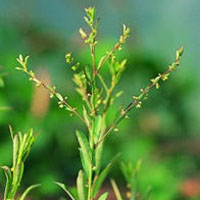Phyllanthus
Uses
Parts Used & Where Grown
Phyllanthus is an herb found in central and southern India. It can grow from 30–60 centimeters in height and blooms with many yellow flowers. Phyllanthus species are also found in other countries, including China (e.g., Phyllanthus urinaria), the Philippines, Cuba, Nigeria, and Guam.1All parts of the plant are used medicinally.
Our proprietary “Star-Rating” system was developed to help you easily understand the amount of scientific support behind each supplement in relation to a specific health condition. While there is no way to predict whether a vitamin, mineral, or herb will successfully treat or prevent associated health conditions, our unique ratings tell you how well these supplements are understood by the medical community, and whether studies have found them to be effective for other people.
For over a decade, our team has combed through thousands of research articles published in reputable journals. To help you make educated decisions, and to better understand controversial or confusing supplements, our medical experts have digested the science into these three easy-to-follow ratings. We hope this provides you with a helpful resource to make informed decisions towards your health and well-being.
3 StarsReliable and relatively consistent scientific data showing a substantial health benefit.
2 StarsContradictory, insufficient, or preliminary studies suggesting a health benefit or minimal health benefit.
1 StarFor an herb, supported by traditional use but minimal or no scientific evidence. For a supplement, little scientific support.
This supplement has been used in connection with the following health conditions:
| Used for | Why |
|---|---|
2 Stars Hepatitis 900 to 2,700 mg daily | Taking the herb phyllanthus may be beneficial for people with hepatitis B. (Phyllanthus amarus), an Ayurvedic herb, has been studied primarily in carriers of the hepatitis B virus, as opposed to those with chronic active hepatitis. In one trial, administering this herb for 30 days appeared to eliminate the hepatitis B virus in 22 of 37 cases (59%). However, other trials have failed to confirm a beneficial effect of Phyllanthus amarus against hepatitis B. A West Indian species, Phyllanthus urinaria (not widely available in the United States or Europe), has achieved much better results than Indian Phyllanthus amarus. Thus, the specific plant species used may have a significant impact on the results. The amount of phyllanthus used in clinical trials has ranged from 900–2,700 mg per day. |
1 Star Pain Refer to label instructions | Extracts of phyllanthus plants have shown a marked ability to decrease pain, apparently by decreasing inflammation. With liver-protective properties, they may be safer than drugs such as acetaminophen, which has toxicity to the liver. In animal research, alcohol/water extracts of plants from the genus (25 to 200 mg per 2.2 pounds body weight) have shown a marked ability to decrease pain. This family includes the plants Phyllanthus urinaria, P. caroliniensis, P. amarus, and P. niruri. Like aspirin, phyllanthus extracts appear to reduce pain by decreasing inflammation. Although they are six to seven times more potent than aspirin or acetaminophen in test tube studies, extracts of these plants also demonstrate liver-protective properties, suggesting they may be safer than drugs such as acetaminophen, which has well-documented toxicity to the liver. The usefulness of phyllanthus extracts for treating pain in humans is unknown. |
Traditional Use (May Not Be Supported by Scientific Studies)
Phyllanthus has been used in Ayurvedic medicine for over 2,000 years and has a wide number of traditional uses including internal use for jaundice, gonorrhea, frequent menstruation, and diabetes and topical use as a poultice for skin ulcers, sores, swelling, and itchiness. The young shoots of the plant are administered in the form of an infusion for the treatment of chronic dysentery.2
How It Works
Phyllanthus primarily contains lignans (e.g., phyllanthine and hypophyllanthine), alkaloids, and flavonoids (e.g., quercetin).
Phyllanthus blocks DNA polymerase, the enzyme needed for the hepatitis B virus to reproduce. In one study, 59% of those infected with chronic viral hepatitis B lost one of the major blood markers of HBV infection (e.g., hepatitis B surface antigen) after using 900 mg of phyllanthus per day for 30 days.3 While clinical trials on the effectiveness of phyllanthus for HBV have been mixed, the species P. urinaria and P. niruri seem to work better than P. amarus.4 Clinical trials with hepatitis B patients have used 900–2,700 mg of phyllanthus per day.
How to Use It
Research has used the powdered form of phyllanthus ranging from 900–2,700 mg per day for three months.5
Interactions with Supplements, Foods, & Other Compounds
Interactions with Medicines
Side Effects
1. Bharatiya VB. Selected Medicinal Plants of India. Bombay: Tata Press, 1992, 235-7.
2. Nadkarmi KM. India Materia Medica, vol 1. Bombay: Popular Prakashan Private Ltd., 1993, 947-8.
3. Thyagarajan SP, Subramanian S, Thirunalasundar T, et al. Effect of Phyllanthus amarus on chronic carriers of hepatitis B virus. Lancet 1988:2:1017-8.
4. Wang M, Cheng H, Li Y, et al. Herbs of the genus Phyllanthus in the treatment of chronic hepatitis B: observations with three preparations from different geographical sites. J Lab Clin Med 1995;126:350-2.
5. Reichert R. Phytotherapeutic alternatives for chronic hepatitis. Quart Rev Natural Med 1997;Summer:103-8.
Last Review: 06-08-2015

Copyright © 2024 TraceGains, Inc. All rights reserved.
Learn more about TraceGains, the company.
The information presented by TraceGains is for informational purposes only. It is based on scientific studies (human, animal, or in vitro), clinical experience, or traditional usage as cited in each article. The results reported may not necessarily occur in all individuals. For many of the conditions discussed, treatment with prescription or over the counter medication is also available. Consult your doctor, practitioner, and/or pharmacist for any health problem and before using any supplements or before making any changes in prescribed medications. Information expires December 2024.
This information does not replace the advice of a doctor. Ignite Healthwise, LLC, disclaims any warranty or liability for your use of this information. Your use of this information means that you agree to the Terms of Use. Learn how we develop our content.

